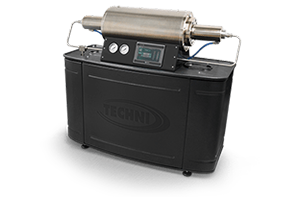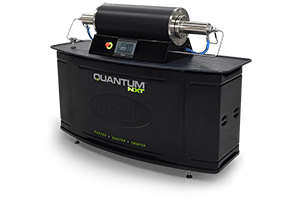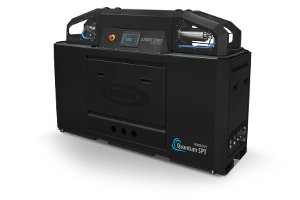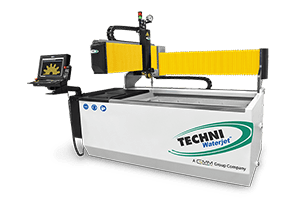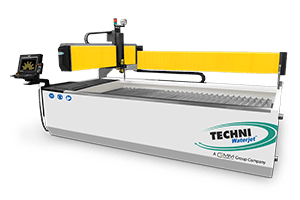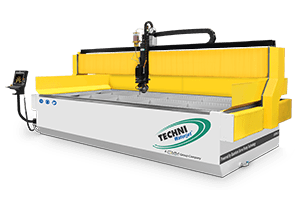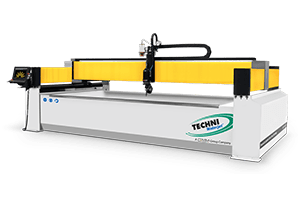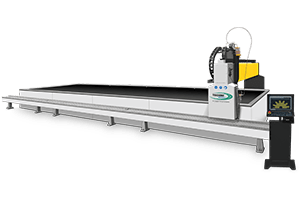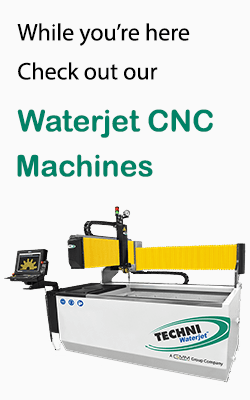There are a wide variety of water jet nozzles available in the market. When it comes to waterjet cutting, there is a dedicated nozzle providing an ideal solution for each requirement. For the best results, you must choose the right nozzle for the job.
Therefore, it is essential to understand ‘what is a water jet nozzle?’ and its many different types. This article will explore all there is to know about waterjet nozzles, their types, specifications, materials, and a guide to selecting the best one.
What is a Waterjet Nozzle?
A waterjet nozzle is the part that focuses the water stream on the desired workpiece location. It is the final part of the water delivery system of the machine.
It is also known as the focusing tube or the mixing tube. The waterjet nozzle is made of extremely sturdy construction to handle the ultra-high hydraulic power involved with waterjet cutting.
Due to the highly pressurized water, nozzle wear is common in waterjet cutting. Therefore, the water jet nozzle is a machine part that requires periodic replacement.
What is the Purpose of the Water Jet Nozzle?
The purpose of the water jet nozzle is to focus the water stream on the workpiece. The optimal width of the water stream for cutting varies for every material and thickness.
Therefore, a nozzle ensures you can use the appropriate water jet nozzle for the best cutting result. The nozzle contains a jewel orifice for the exit of the water stream. This helps in the longer lifespan of the entire assembly.
What are the Different Types of Nozzles?
There are two different types of water jet nozzles. These are:
Pure Water Jet Nozzle
A pure water jet nozzle is used in waterjet cutting that does not use any abrasive. It applies in waterjet cutting of soft materials like paper, foam, rubber, textiles, cardboard, and plastics that do not need abrasive waterjet cutting.
Due to the absence of abrasive particles, the size of the orifice can be extremely narrow.
Abrasive Water Jet Nozzle
An abrasive water jet nozzle is used in the abrasive waterjet cutting of hard materials that the force of the water alone cannot cut feasibly. An abrasive jet nozzle design differs greatly from a pure water jet nozzle.
An abrasive jet nozzle has an additional mixing chamber where the abrasive particles are introduced in the water. There is an inlet into the nozzle for the entry of abrasive particles.
The purpose of the high-pressure water is for the acceleration of the abrasive particles. The material is cut with high-velocity abrasive particles Commonly cut materials with abrasive jet nozzles are metals, alloys, ceramics, composites, stone, glass, etc.
Specifications of a Water Jet Nozzle
There are many technical specifications to learn about water jet nozzles to understand how to differentiate between the different options. These specifications are:
Orifice Diameter
The orifice diameter is the width of the gap in the jewel orifice. A lower orifice diameter means a more narrow water jet stream. Using a small orifice diameter will create a higher-pressure water jet. However, it will also increase the nozzle wear tremendously. This creates a more frequent need for nozzle replacement.
What is the diameter of a water jet cutting nozzle?
The diameter of a water jet cutting nozzle is generally three times the nozzle orifice diameter.
The nozzle orifice diameter is kept small enough to keep the kerf width minimum and accuracy at the maximum.
However, the value should not be too small because it will reduce the cutting speed and increase nozzle wear.
Flow Rate
The flow rate is defined as the water volume that goes through the orifice per unit time. Flow rate is a numerical value measured in Litre per minute (LPM) or Gallons per minute (GPM). A higher flow rate increases the speed of the waterjet cutting. However, it also increases the nozzle wear.
Nozzle Size
The nozzle size refers to the width of the nozzle bore hole. This value is three times the orifice diameter. The size of the water jet cutting nozzles can be divided into three segments:
- Small Nozzles: A small nozzle is used when high accuracy or intricate details are required in the water jet cutting process. The diameter of these nozzles can range from 0.254 mm to 1.016 mm (0.01 in to 0.04 in). Small nozzles provide a higher control of the cutting process.
- Medium Nozzles: Medium nozzles are used when working on surfaces or during general cutting operation. The precision is not the primary requirement for the medium nozzle cutting operation. The nozzle bore diameter can vary between 1.016 mm to 2.032 mm (0.04 in to 0.08 in).
- Large Nozzle: Large nozzle is used when high speed cutting is the primary requirement. They can process bulk material cutting at a rapid rate. The nozzle bore diameter ranges from 2.032 mm to 6.35 mm (0.08 in to 0.25 in).
Pressure Rating
Pressure rating is the maximum amount of water pressure that the nozzle can handle optimally. Exceeding the water pressure beyond this limit can degrade the nozzle severely and even cause nozzle breakdown. The pressure rating can vary from nozzle to nozzle. The manufacturers provide this value with the replacement nozzle.
How much pressure is in a waterjet nozzle?
Modern waterjet cutting nozzle can reach pressures as high as 90,000 psi. However, such extreme values cause wear of all the internal components, including the nozzle. Water pressures between 40,000 psi to 60,000 psi are considered the best for optimal performance and long life of the nozzle.
What Material Is Used For Making Waterjet Nozzles?
There are many different options for waterjet nozzle materials. The exact choice of material can vary depending on the intended lifespan, pressure rating, applications, and cost limits. Common materials for waterjet nozzle are:
Tungsten Carbide: Tungsten Carbide is the most popular material for waterjet nozzles. Tungsten Carbide nozzles fare exceptionally well in terms of performance and strength. The hardness of Tungsten Carbide is similar to diamond. Tungsten Carbide nozzles are rated for extreme waterjet pressures up to 90,000 psi. With ideal usage, Tungsten Carbide nozzles can last for over 200 hours. With rough use, these nozzles can require replacement after 100 hours.
Sapphire: Sapphire nozzles provide high durability and an affordable cost. Additionally, these nozzles are completely chemically inert. The lifespan of these nozzles is at the shorter end of the scale, lasting for around 50 to 100 hours. These nozzles are good up to 60,000 psi to 70,000 psi water pressure. Ruby nozzles in the market also have identical properties to the sapphire nozzles.
Diamond: Diamond nozzles are the best in terms of durability and hardness. These nozzles can withstand the most extreme water pressures and the hardest abrasives. The lifespan of these nozzles is also the longest. It is common for many diamond nozzles to come with a 1000 hour life expectancy. These nozzles are also the most expensive choice, costing around twenty times more than sapphire nozzles. They can be cost-effective in bulk abrasive jet cutting of very hard materials.
Ceramics: Ceramic nozzles are emerging as an innovative material choice for waterjet cutting. These nozzles can be even more durable than hardened steel. These nozzles are completely corrosion-resistant. The lifespan of a ceramic nozzle depends on the material used in the particular nozzle.
Nozzle Connection Type
There are multiple connection types available for waterjet cutting nozzles Two of the most common connection types are:
- Threaded Nozzles: Threaded connection has screw-like threads on the nozzle connector ends. This requires a proper tooling to fit and remove the nozzles. However, threaded nozzles can handle extreme pressures and are completely leak-free with proper fitting. Threaded nozzles ensure that there are no accidental disconnects during operation.
- Quick-Connect Snap Nozzles: Quick-connect snap nozzles are also marketed as quick-disconnect nozzles. These nozzle couplings don’t require dedicated tools for fitting or dismantling the nozzle. These are completely unthreaded nozzles. There are generally snap mechanisms in place that can lock the nozzle on the machine. Generally, quick-connect nozzles cannot handle ultra high pressure like the threaded nozzle. However, quick-connect nozzles are very convenient to use and replace. The mechanical locks can sometimes accidentally disconnect during operation.
- Quick-Connect Screw Nozzles: Quick connect screw nozzles are threaded variations of the snap nozzles. There are locking mechanisms in place but the nozzle requires additional screwing, which is fairly easy. These nozzles are more secure than snap nozzles and don’t disconnect during operation.
What Materials Can a Waterjet Nozzle Cut?
Waterjet nozzles can cut through virtually any material. Some of the common materials are:
- Metals: Waterjet is able to cut through the hardest metals and metal alloys such as hardened steel. Metal cutting requires an abrasive jet nozzle for a smooth and fast operation.
- Ceramic: Waterjet cutting is commonly used for cutting ceramic tiles and stone. It may use an abrasive jet nozzle or a pure waterjet nozzle, depending on the type of ceramic.
- Glass: Waterjet cutting glass is common in art, construction, decor, and many other sectors. Abrasive jet nozzles can cut through any glass, including bullet proof glass.
- Rubber: Waterjet is a great way to cut rubber. Rubber can be cut with a pure waterjet nozzle at low pressures. This makes it a very cost-effective option.
- Plastics: Waterjet can cut through any plastic without heating it. Plastic cutting usually requires an abrasive jet nozzle.
- Foam: Waterjet cutting foam creates very clean cuts without any burn marks. It is a cheap cutting method using a pure waterjet nozzle.
- Thin Films: Waterjet is a great way to cut very thin foils and films (such as aluminum foil). A pure waterjet nozzle is enough for cutting thin foils even made of metals.
- Wood: Soft or thin wood can be cut with a pure waterjet nozzle. Hardwoods or very thick woods require an abrasive jet nozzle.
How to Choose the Right Waterjet Nozzle?
Choosing the right waterjet nozzle should be done considering several factors. These factors are:
- Application: The primary decision for choosing the right nozzle is based on the particular application. Certain applications can straightaway eliminate many of the available nozzle options. For instance, applications involving high pressures cannot use snap connection type nozzles.
- Material: There are many different options for the nozzle material. Choose a suitable material based on whether or not you would be using an abrasive. Factor in how often you want to make nozzle replacements. Different materials have different lifespans. If you don’t mind investing in quality, diamond can be a good choice. Tungsten Carbides are tried and tested nozzles that are the most commonly used.
- Orifice Size: The size of the orifice is also very application specific. The size depends on the type of material and its thickness. There is no standard orifice size suited for all applications. Find out the orifice size based on manufacturers instructions or by trying different options for your use cases.
- Pressure Rating: Once you have decided on a nozzle, ensure its maximum pressure rating is safely above the water pressure you use.
- Manufacturer: Opting for a trusted and reliable manufacturer is always recommended instead of a third-party option. Manufacturers such as Techni Waterjet provide long-term reliability with spare part availability and technical support when needed.
How Long Does a Waterjet Nozzle Last?
A waterjet nozzle can last anywhere from 40 hours to 1000 hours. The lifespan mainly depends on the nozzle material and the usage conditions.
Misusing the nozzle can significantly degrade its performance and provide a lower lifespan.
What is the Cost of a Water Jet Nozzle?
The cost of a waterjet nozzle can start at $20 and go over $400. The price of the nozzle is not a direct relation to its cost-effectiveness.
A $400 diamond nozzle might be more cost-effective than a $20 sapphire nozzle due to its longer lifespan and less downtime due to replacements.
Therefore, the running cost of the nozzle varies depending on the particular use case. Tungsten Carbide nozzles are a good middle ground, costing around $50 to $100.
Endnotes
The nozzle is an integral part of a water jet system. The tiny hole in the nozzle focusing tube is responsible for the high-speed water that can pierce through the hardest materials.
However, choosing the wrong nozzle can lead to disastrous results such as poor accuracy, sharp corners, water spread, and slow cutting speeds. Follow the information above to get the best nozzle fit for your project.
Feel free to contact us if you need an expert advice. Our team is always ready to help!
